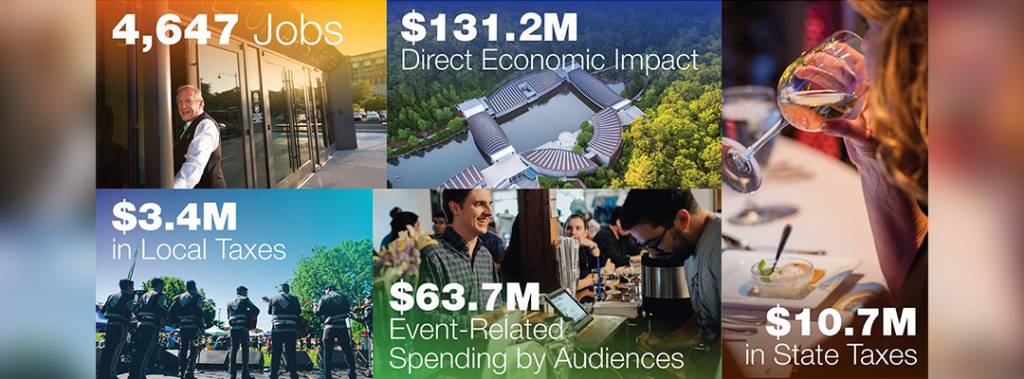A recent study by Americans for the Arts has found that Northwest Arkansas’ nonprofit arts and culture industry generated $131.2 million in economic activity in 2015 – $67.5 million in spending by arts and culture organizations and an additional $63.7 million in event-related spending by their audiences. This activity supported 4,647 jobs and generated $14 million in government revenue. The complete report for Benton and Washington counties is available here.
The Arts & Economic Prosperity® Study is conducted nationally every five years. AEP5, the fifth study to be completed, documents the economic contributions of the nonprofit arts industry across the country as well as in 341 study regions, representing all 50 states and the District of Columbia during Fiscal Year 2015. Northwest Arkansas, defined for this purpose as Benton and Washington counties, was the only Arkansas study region included in the report. Crystal Bridges Museum of American Art and the Scott Family Amazeum were not yet online for the 2010 study.
“Arts and Economic Prosperity 5 quantifies the economic benefits of arts and culture organizations within a community,” said Randy Cohen, vice president of Research and Policy for the American for the Arts. “This study changes the conversation about the arts from that of a ‘charity’ to one about an ‘industry’ that provides both cultural and economic benefits to the community.” Cohen detailed the findings today during a news conference at the Rogers World Trade Center.
Key AEP5 Findings for NWA:
- Nearly 1.8 million people attended arts and culture events in Northwest Arkansas in 2015. Crystal Bridges welcomed 608,000 visitors in 2015. Event-related spending by these attendees totaled $63.7 million, excluding the cost of admission, or roughly $35.89 per person. That’s slightly higher than the national average of $31.47 per person and almost double the $19.54 per person spending in the Northwest Arkansas region documented by Arts and Economic Prosperity IV (AEPIV), covering Fiscal Year 2010.
- The economic impact of the arts accounts for more than the monies spent in communities by residents. Cultural tourists spend money, as well. Twenty-five percent of attendees traveled from outside of the county in which the event took place. Their event-related spending on average was 199% more per person than local attendees ($71.20 vs. $23.85).
- A vibrant arts community not only keeps residents and their discretionary spending closer to home, it also attracts visitors who spend money and help local businesses thrive. Eighty-six percent of nonlocal attendees indicated that the primary purpose of their visit was “specifically to attend this arts or cultural event.”
- Among local attendees, 42 percent said they would have traveled to a different community to attend a similar cultural event, if the arts event they wanted to attend was not taking place.
- Comparing results from AEPIV and AEP5 shows that the arts industry in Northwest Arkansas has grown significantly, due in large part to the addition of the Walmart AMP and Crystal Bridges Museum of American Art between FY10 and FY15.
- Total economic impact is up 124%.
- Number of jobs is up 212%
- Local and state revenue is up 248%
- Resident spending is up by 50% and non-resident spending is up 97%
Key AEP5 Findings Nationally:
- Nonprofit arts industry generated $166.3 billion of economic activity in 2015—$63.8 billion in spending by arts and cultural organizations and an additional $102.5 billion in event-related expenditures by their audiences.
- This industry supported 4.6 million jobs and generated $27.5 billion in revenue to local, state, and federal governments—a yield well beyond their collective $5 billion in arts allocations.
- Money spent by nonprofit arts and cultural organizations supported a larger share of the U.S. workforce—0.83 percent—than the legal or public safety sectors.
The study includes 23 nonprofit arts and cultural organizations located in Northwest Arkansas. Each partner provided detailed budget information for FY15 including labor, payments to local and nonlocal artists, operations, administration, programming, facilities and capital expenditures/asset acquisition. And 822 patrons were surveyed about spending around their attendance to arts events. Project economists customized input-output models for each study region to ensure reliable and actionable localized results.
“With current threats of cutting funding for nonprofit organizations, this study is timely,” Cohen said. “The $27.5 billion generated in revenue by the arts industry nationally back to the government shows that municipal, state and federal arts support is not a one-way street. Arts organizations provide jobs, support the economy and the government while they also educate, entertain and increase our quality of lives.”
The full report, a map of the 341 study regions and an economic impact summary for each can be found at www.AmericansForTheArts.org.




